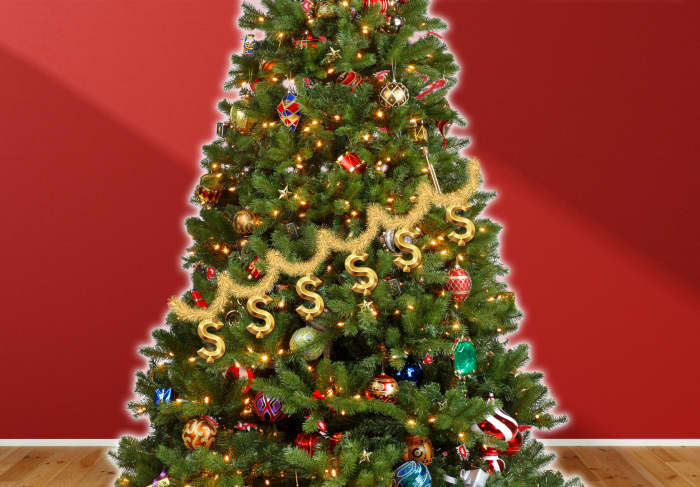If you’re planning on buying a Christmas tree this year, start thinking about it now — and maybe put some money aside.
Supply-chain disruptions and global inflation have affected the supply and prices of Christmas trees this year, both artificial and real ones, industry experts said.
With inflation at a 40-year high and prices of consumer goods and services up 8.2% in September compared with last year, Americans are cutting back on discretionary spending and dipping into savings to pay their bills.
“Even if Americans cut back on other items, it’s likely that they will keep the Christmas tree.”
They are also hunting for bargains: 58% of consumers said sales and promotions are more important to them than they were last year, according to the holiday-season survey by the National Retail Federation.
While Americans say they are trying to cheat inflation this year by buying more practical gifts for loved ones or cutting down on their gift-giving altogether, consumer demand for Christmas trees remains strong, industry experts said.
Even if Americans cut back on other items, it’s likely that they will keep the traditional tree, Mac Harman, CEO of Balsam Brands, a holiday and home-decor retailer that owns the artificial-tree seller Balsam Hills, told MarketWatch.
“Maybe they’re going to have fewer presents,” Harman said. A bad-looking or half-dead tree or, worse, no tree at all, he said, would be a “really scary signal to your kids, because [the tree is] such a part of tradition.”
Here’s how to secure a (nice) tree this Christmas:
If you’re buying a real tree, it will cost you
Real trees are likely to get more expensive due to increasing costs for things such as fertilizer and labor. All 55 growers polled in August by the Real Christmas Tree Board — which covers about two-thirds of the U.S. market share in total — said their costs had increased compared with last year.
More than one-third of growers said costs had risen by 11% to 15%, while more than one-quarter said costs had risen by 16% to 20% compared with the previous year.
As a result, 71% of the polled growers expected wholesale prices to increase 5% to 15% compared with last year, 11% expected prices to rise 20% more, and 11% saw prices rising no more than 5%.
Last year, the median retail price for a real fir, pine or spruce tree was $69.50, according to a consumer survey by the National Christmas Tree Association, which represents Christmas-tree growers. The median price of an artificial tree was $70. (The trade group changed its methodology this year and did not provide comparable prices from previous years.)
“‘The real-Christmas-tree industry is bigger than any one farm, retailer or region — and we’ve never run out of trees.’”
“Of course, prices vary based on location and type of tree,” Tim O’Connor, executive director of the National Christmas Tree Association, told MarketWatch.
In addition to the potential increase in wholesale prices, other costs including transportation, rent, utilities and labor could further push up the cost of trees this year, Balsam Brands’ Harman said.
Some good news: The supply of real trees should be broadly in line with last year, said Marsha Gray, executive director of the Real Christmas Tree Board.
Although there have been reports of extreme weather affecting tree crops, the Christmas-tree industry is big and farms are scattered, Gray told MarketWatch. What’s more, farmers use long-term strategies to account for short-term weather disruptions.
The heat wave in the Pacific Northwest last year, for example, affected seedlings and scorched some tree branches, Gray said, but because of the 8- to 10-year life cycle of the crop, farmers were able to manage their inventories to prevent a shortage.
“The real-Christmas-tree industry is bigger than any one farm, retailer or region — and we’ve never run out of trees,” she said.

Last year, some artificial trees arrived at retailers after Christmas because of pandemic-related supply-chain disruptions.
MarketWatch photo illustration/iStockphoto
If you’re buying an artificial tree, shop early
Supply-chain issues could, however, disrupt the artificial-tree market this year, Harman said.
Last year, boxes of artificial Christmas trees arrived at retailers after Christmas because of pandemic-related supply-chain disruptions. Since then, retailers have been storing trees in their distribution centers, “which is not what you want, because Christmas trees are bulky,” he added.
And it’s not just artificial trees. The inventory-to-sales ratio for general-merchandise stores reached a 15-year high in the second quarter, meaning retailers were losing money sitting on unsold supplies.
“Consumers started online searches for artificial Christmas trees last summer, which is a lot earlier than usual.”
“If you have a specific tree in mind that will make your holiday shine the brightest, we recommend shopping early to secure your ideal tree at the right price for your family,” Jami Warner, executive director of the American Christmas Tree Association, said in a statement. The association provides information on the industry to consumers and the media.
Balsam Brands’ Harman noted that after many people moved out of cities and into larger homes during the pandemic, more people are now putting up multiple trees.
Consumers started searching online for artificial Christmas trees last summer, a lot earlier than usual, said Dallin Hatch, head of communications at e-commerce accelerator Pattern. The search for artificial trees on Amazon
AMZN,
spiked in July and August, he said, with searches up 60% in July and 41% in August over the previous year.
The spikes in searches coincided with news reports of drought and heat waves affecting tree farmers, Hatch said.
“We haven’t seen consumers shopping in this volume for Christmas trees this early. And I doubt that is something that these Christmas-tree manufacturers could have foreseen beforehand,” Hatch said.
People want to celebrate old traditions and let loose after a rough two years of the pandemic, he said, “and sometimes a tree is a symbol of that.”
